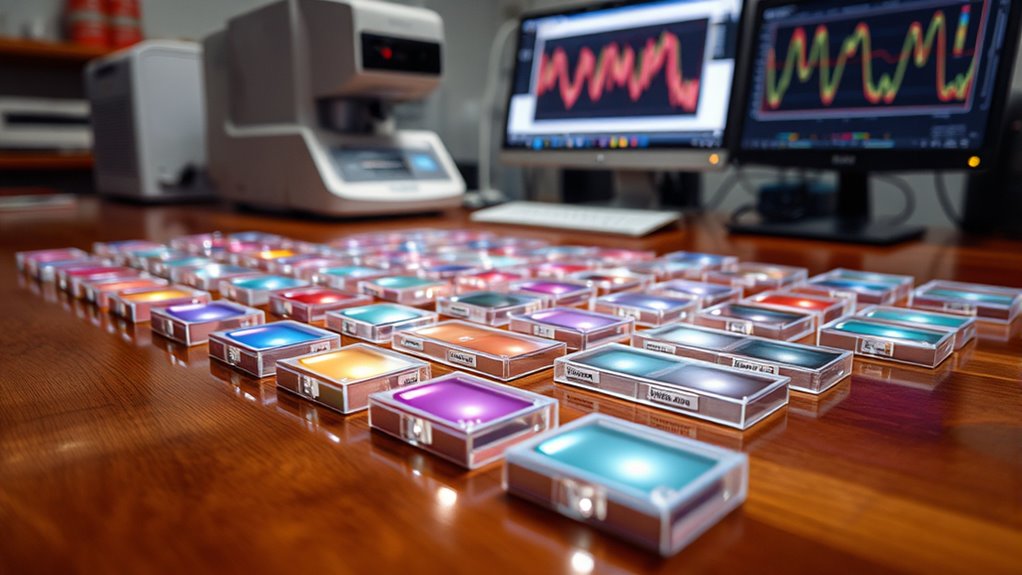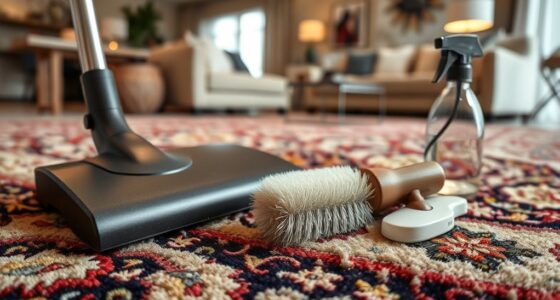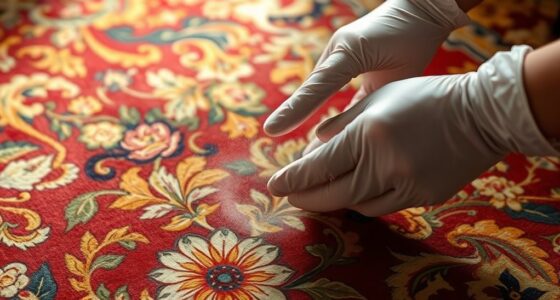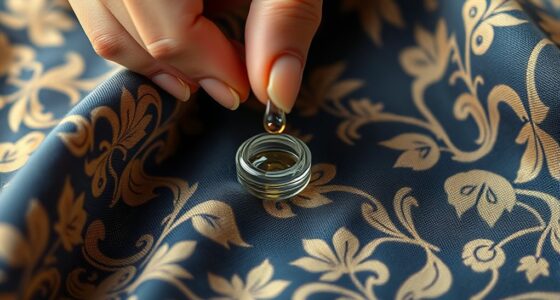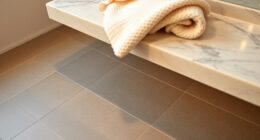Microfading tests enable you to precisely measure how sensitive fragile materials are to light exposure, helping you prevent irreversible damage. By applying controlled, small-scale light sources, you can monitor color fading to gauge damage thresholds. This non-invasive method offers more accurate, early detection of light sensitivity compared to traditional tests. If you want to understand how this technique can safeguard valuable objects, explore how it supports effective preservation strategies and risk assessments.
Key Takeaways
- Microfading tests measure how quickly a material’s color fades under controlled light exposure to quantify its light sensitivity.
- The technique uses small, localized samples with specialized sensors to monitor fading in real-time.
- Data from microfading tests establish quantitative thresholds, helping conservators determine safe light levels.
- It enables early detection of damage, allowing for preventive conservation before irreversible harm occurs.
- The method offers precise, non-invasive assessment of pigment and material vulnerability to light exposure.
Understanding Microfading Testing and Its Purpose
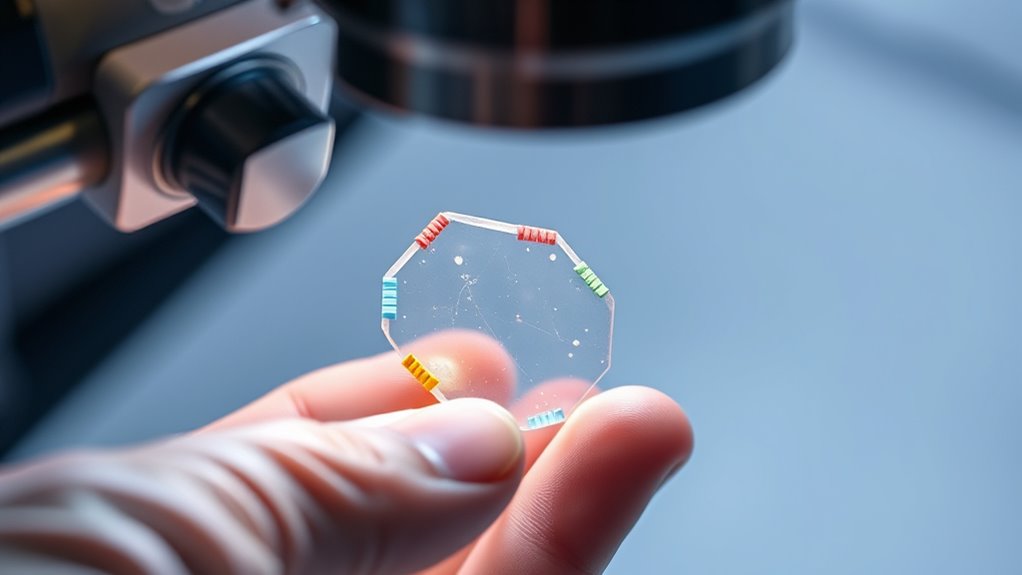
Microfading testing is a non-invasive method used to assess the light sensitivity of fragile materials, such as artworks and historical documents. It allows you to measure how quickly colors fade when exposed to light, providing insight into potential material degradation. By targeting small, controlled areas, you can observe subtle changes in color without damaging the piece. This process helps you determine the safe exposure levels for vulnerable materials, guiding preservation strategies. Understanding how materials respond to light ensures you can prevent further deterioration and prolong the lifespan of valuable objects. Additionally, knowledge of self watering plant pots can inform the design of preservation environments by maintaining appropriate humidity levels. Recognizing the importance of symbolism in prophetic dreams can deepen your understanding of the messages conveyed. Moreover, incorporating climate control strategies such as humidity regulation can further enhance conservation efforts. Proper toilet maintenance and understanding flushing mechanisms can also prevent accidental damage during preservation work. Staying informed about personal development techniques can also improve your ability to manage stress and maintain focus during conservation projects. Ultimately, microfading testing helps you make informed decisions about display and storage, balancing visibility with conservation needs to maintain both the integrity and appearance of your collection.
The Principles Behind Microfading Technology
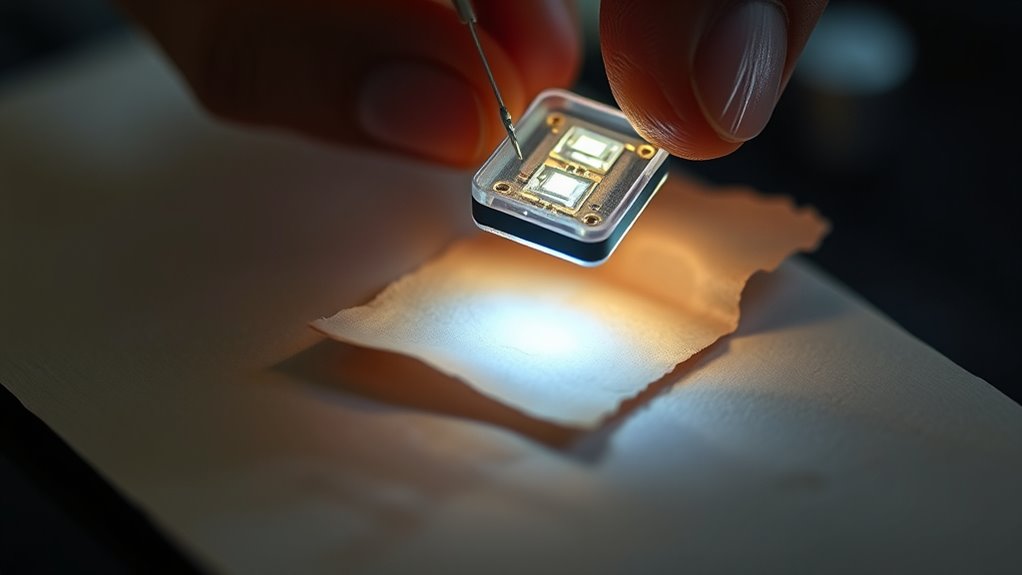
Microfading technology relies on precise light exposure to test material stability, using a specialized sensor and light source that target small areas. As the light interacts with the sample, data is collected quickly and accurately to monitor changes over time. Understanding how these components work together helps you grasp how microfading predicts the longevity of your artifacts. Additionally, knowledge of light sensitivity and how different materials respond to environmental factors is essential for accurate testing and preservation. Recognizing the types of headphone jacks used in various devices can also be beneficial when considering equipment compatibility during testing procedures. To ensure reliable results, consistent maintenance of testing equipment, such as calibrating sensors and light sources, is crucial for accurate measurements. Incorporating data-driven strategies into your testing protocols can further enhance the precision and predictive power of your assessments. Proper calibration and regular maintenance of the testing equipment are vital to maintaining the integrity of your results.
Light Exposure Mechanism
Understanding the light exposure mechanism is essential to grasp how microfading technology assesses artifact stability. It relies on controlled light exposure, where you adjust light intensity and exposure duration to simulate real-world conditions. By precisely controlling these factors, the device measures how materials respond to light, indicating their sensitivity. The mechanism guarantees consistent, repeatable results, avoiding unnecessary damage. Here’s a simplified overview:
| Light Intensity | Exposure Duration | Effect on Material |
|---|---|---|
| Low | Short | Minimal fading |
| Moderate | Moderate | Noticeable fading |
| High | Long | Accelerated fading |
| Very High | Very long | Potential damage |
| Variable | Variable | Custom testing |
This setup enables accurate quantification of a material’s light sensitivity, and understanding material response is crucial for preserving artifacts effectively. Recognizing how different light levels impact various materials helps conservators tailor their approaches for optimal protection, especially through data analytics that monitor material behavior over time. Additionally, incorporating standardized testing protocols ensures consistency and reliability in measurements across different scenarios. To enhance the reliability of results, calibrating equipment regularly is also recommended, as it ensures measurement accuracy remains high.
Sensor and Light Source
A critical component of microfading technology is its sensor and light source system, which work together to deliver precise, controlled illumination. The sensor detects changes in the material’s color or fading, so accurate sensor calibration is necessary to ensure reliable measurements. Proper calibration aligns the sensor’s readings with known standards, minimizing errors. The light source provides consistent light intensity, essential for reproducible results and preventing overstimulation of sensitive materials. You control the light’s intensity carefully to avoid damaging the sample while still obtaining meaningful data. This synergy ensures the accuracy and repeatability necessary for effective light sensitivity assessment. Additionally, understanding the environmental considerations associated with measurement devices can help in developing safeguards against potential cyber threats. Ensuring proper sensor calibration is vital for the precision of the measurements, especially when working with delicate or highly sensitive samples.
Data Collection Process
To accurately measure how materials fade under light exposure, your data collection process relies on precise timing and controlled conditions. You monitor color fading by exposing small areas to controlled light levels, ensuring consistent environmental monitoring throughout. This approach minimizes external influences, providing reliable data on how materials respond over time.
| Step | Purpose |
|---|---|
| 1 | Initiate exposure |
| 2 | Record initial color data |
| 3 | Monitor environmental factors |
| 4 | Measure fading progression |
Materials and Techniques Used in Microfading Analysis

Microfading analysis relies on a carefully selected combination of materials and techniques to accurately evaluate the fading susceptibility of delicate artifacts. You’ll use specialized equipment and materials to guarantee precise results.
- UV filters are vital to protect samples and control light exposure, preventing premature pigment degradation.
- Microfading devices emit controlled, focused light to simulate natural aging and measure color changes precisely.
- High-quality, stable pigments and substrates are used to minimize interference and ensure reliable data during testing.
These materials help you isolate the effects of light on sensitive pigments, providing clear insights into their vulnerability. Proper UV filtering and careful technique are essential for assessing light sensitivity accurately while avoiding artifacts caused by external factors.
Interpreting Results: What Light Sensitivity Means for Preservation
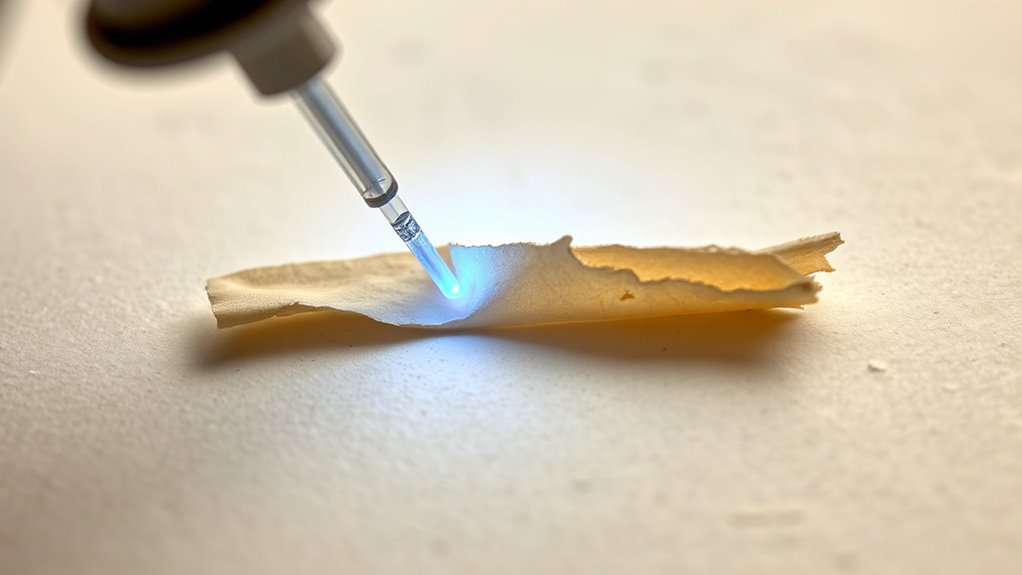
Understanding the results of microfading tests is essential for determining how sensitive your artifacts are to light exposure. If a piece shows high light sensitivity, you should prioritize specific conservation strategies to minimize damage. This might include reducing light levels, limiting exposure time, or using UV filters. Recognizing an object’s light sensitivity helps you assess collection risk more accurately, guiding you to balance preservation needs with display or research requirements. Conversely, if an artifact demonstrates low sensitivity, you can be more flexible with lighting conditions without jeopardizing its integrity. Interpreting these results enables you to tailor preservation approaches, ensuring your collection’s longevity. Ultimately, understanding light sensitivity helps you make informed decisions that protect your artifacts from unnecessary deterioration.
Advantages of Microfading Over Traditional Lightfastness Tests
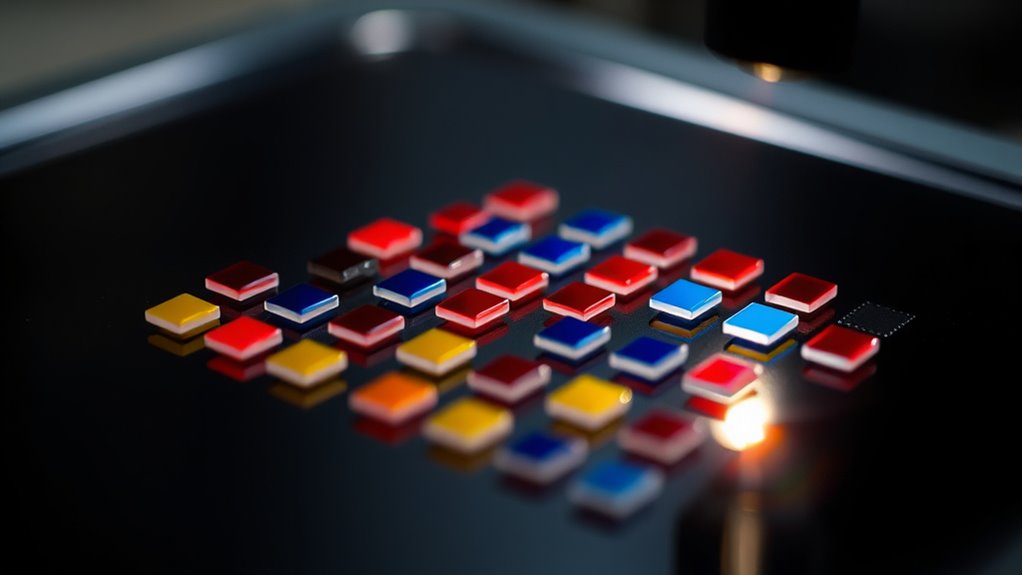
Microfading tests offer more precise damage measurement compared to traditional methods, helping you detect changes early. You’ll need only minimal samples, which is less invasive for valuable artifacts. Additionally, these tests can be accelerated, giving you faster results without sacrificing accuracy.
Precise Damage Measurement
Unlike traditional lightfastness tests, microfading allows for highly precise measurement of pigment damage by focusing on tiny, localized areas. This technique enables you to detect subtle changes at the damage threshold, where minimal light exposure causes initial damage. By controlling light intensity, you can pinpoint exactly when pigments begin to fade, avoiding unnecessary sample destruction. Microfading’s precision offers these advantages:
- Accurate detection of early damage, ensuring timely intervention
- Fine-tuned assessment of light sensitivity at specific spots
- Quantitative data on the damage threshold, improving conservation decisions
This precision helps you understand how a pigment reacts to light exposure, providing reliable, detailed insights into its lightfastness. Consequently, microfading enhances your ability to protect artworks with minimal sample impact.
Minimal Sample Requirement
Because microfading tests require only tiny samples, they considerably reduce the amount of artwork or material needed for analysis compared to traditional lightfastness methods. The small sample size simplifies sample preparation, allowing you to work with minimal material without sacrificing accuracy. This means less invasive testing and preservation of original pieces. You can obtain reliable results using just a fraction of the sample required for conventional tests, making it ideal for precious or fragile items. The minimal sample requirement also enables testing in situations where sample availability is limited or where sampling needs to be nondestructive. Overall, microfading offers a more efficient, less invasive approach, preserving the integrity of artworks while providing essential data on light sensitivity.
Accelerated Testing Capabilities
One significant advantage of microfading tests is their ability to deliver rapid results through accelerated testing. This approach allows you to simulate long-term light exposure in a short time, which is essential when considering the historical context of material degradation. Traditional lightfastness tests can take weeks or months, but microfading accelerates this process by applying controlled light doses.
Here’s what makes this method superior:
- Quick insights into how materials will age, saving you time.
- Better understanding of degradation pathways without waiting years.
- Precise data on light sensitivity, helping protect valuable artifacts or artworks.
Practical Applications and Future Developments in Microfading Science

Microfading tests have become an invaluable tool for conservators aiming to assess the light sensitivity of fragile materials quickly and accurately. In practical applications, digital imaging allows you to document subtle color changes over time, providing detailed records of material degradation. Optical sensors play a pivotal role by delivering precise measurements of light exposure and material response during testing. These technologies enable you to identify vulnerable areas and make informed decisions about display and storage conditions. Looking ahead, advancements in sensor sensitivity and imaging resolution will further refine your ability to predict fading risks. As microfading science evolves, expect integration with portable devices and automated analysis, making light sensitivity assessments more accessible and efficient for conservation professionals worldwide.
Frequently Asked Questions
How Long Does a Typical Microfading Test Take?
A typical microfading test usually takes about 30 to 60 minutes, depending on the number of procedural steps involved. You start by preparing the sample and setting up the equipment, then carefully focus the light source. During the test, you monitor changes in the sample’s color or fluorescence. The entire process involves precise measurements and data recording, ensuring you gather accurate results while managing the test duration efficiently.
Can Microfading Detect All Types of Material Degradation?
Think of microfading as a detective with sharp eyes, but even this expert isn’t omniscient. When it comes to material diversity, it excels at detecting light-induced changes but may not catch all types of degradation, like chemical or biological deterioration. While powerful for light sensitivity, microfading isn’t a catch-all solution; some degradation forms require complementary methods for exhaustive detection.
What Are the Limitations of Microfading Technology?
When considering the limitations of microfading technology, you should note that it relies on small sample sizes, which might not represent whole artifacts accurately. Environmental factors like light and temperature can also influence results, making it harder to obtain consistent data. Additionally, microfading primarily measures light sensitivity and may not detect all types of material degradation, so you need to interpret its results carefully within the broader conservation context.
Is Specialized Training Required to Interpret Microfading Results?
You might wonder if specialized training is necessary to interpret microfading results. Yes, it’s recommended because understanding the data requires interpretation skills that come with proper training. This helps guarantee you accurately assess light sensitivity levels and avoid misjudgments. With the right expertise, you’ll be better equipped to analyze subtle changes, making your evaluations more reliable and meaningful. So, investing in training enhances your overall effectiveness in using microfading technology.
How Cost-Effective Is Implementing Microfading in Conservation Labs?
Imagine adding a new tool to your toolkit—microfading—that’s like planting a seed for future savings. While the initial cost implications might seem high, it can help you detect light damage early, preventing costly restorations later. Considering budget considerations, microfading proves to be a smart investment, offering precise insights that safeguard your collection without draining resources. Over time, it’s a cost-effective way to protect your artifacts efficiently.
Conclusion
As you explore microfading tests, envision shining a gentle, precise light on delicate artwork, revealing hidden vulnerabilities like a whisper of dawn. This technique illuminates the faint flicker of fading that’s invisible to the naked eye, helping you protect treasures before they fade away. By understanding light sensitivity through microfading, you become a vigilant guardian, ensuring masterpieces remain vibrant and alive, even as time and light threaten their existence.
